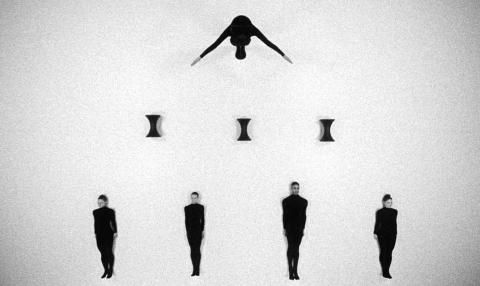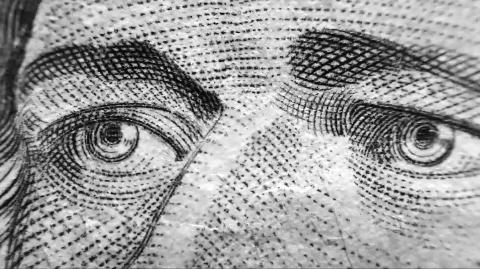Their work over the past year has included erotic artbook images with the smutty bits sandpapered out, exploring the commodification of art through dance, telling circuitous personal stories live to an appreciative but perhaps baffled audience and, for the more old school-minded, screen printing.
It is that time of year again — the shortlist for the Turner prize, which for 30 years has been astonishing and entertaining some people, angering and exasperating others. Yesterday, four artists were shortlisted for the 2014 prize, none of them “especially well known” to the wider public, the chair of judges and the director of Tate Britain, Penelope Curtis, unapologetically acknowledged.
“It is a chance for us to bring out some of those names that the smaller art world has been talking about,” she said.

Photo: EPA
None of the four can be easily categorized or pigeonholed. The best known is 41-year-old Dublin-born Duncan Campbell, whose previous work has included fact-meets-fiction biopics. The others are Ciara Phillips, who creates workshop installations with screen prints, textiles and photographs; James Richards, who makes and borrows film and images to create video installations, and Tris Vonna-Michell, who delivers fast-paced spoken-word performances.
The prize is no stranger to presenting challenging, tricky-to-grasp work. Curtis said the four artists had produced “serious work” with a genuine social and political content. “There is perhaps less fun, but I hope we can do the job of communicating why these works are important and why they caught the imagination of many people over the last 12 months.”
Vonna-Michell is known for creating what Tate curator Lizzie Carey-Thomas called “circuitous, densely-layered and elaborately constructed tales” delivered live or as recordings.

Photo: EPA
“Always there comes a moment of bewilderment and confusion as we’re bombarded with all this information and anecdotes and stories, and this is the point,” she said.
Phillips showed “an incredibly strong graphic sensibility, a really vibrant use of color and a sense of humor” in her screen prints, according to Helen Legg, the director of Spike Island in Bristol and one of this year’s judges.
Campbell is shortlisted for his presentation in the Scottish pavilion of last year’s Venice Biennale in which he screened the 1953 arthouse film by Chris Marker and Alain Resnais, Statues Also Die, which explores African art and its post-colonial commercialization. Campbell screened a response that explores commodification more widely, using footage that included a new dance work by the choreographer Michael Clark.

Photo: EPA
Richards, the youngest artist on the shortlist at 30, is nominated for Rosebud, which mixes images of nature that he took using a pocket camera with artbook photographs by Robert Mapplethorpe, Man Ray and Wolfgang Tillmans. All had any parts that might arouse coarsely sandpapered out.
All four artists will now prepare work to go on display at Tate Britain, London, from September. The GBP25,000 (US$42,330) winner will be named on Dec. 1.

In the March 9 edition of the Taipei Times a piece by Ninon Godefroy ran with the headine “The quiet, gentle rhythm of Taiwan.” It started with the line “Taiwan is a small, humble place. There is no Eiffel Tower, no pyramids — no singular attraction that draws the world’s attention.” I laughed out loud at that. This was out of no disrespect for the author or the piece, which made some interesting analogies and good points about how both Din Tai Fung’s and Taiwan Semiconductor Manufacturing Co’s (TSMC, 台積電) meticulous attention to detail and quality are not quite up to

April 21 to April 27 Hsieh Er’s (謝娥) political fortunes were rising fast after she got out of jail and joined the Chinese Nationalist Party (KMT) in December 1945. Not only did she hold key positions in various committees, she was elected the only woman on the Taipei City Council and headed to Nanjing in 1946 as the sole Taiwanese female representative to the National Constituent Assembly. With the support of first lady Soong May-ling (宋美齡), she started the Taipei Women’s Association and Taiwan Provincial Women’s Association, where she

Chinese Nationalist Party (KMT) Chairman Eric Chu (朱立倫) hatched a bold plan to charge forward and seize the initiative when he held a protest in front of the Taipei City Prosecutors’ Office. Though risky, because illegal, its success would help tackle at least six problems facing both himself and the KMT. What he did not see coming was Taipei Mayor Chiang Wan-an (將萬安) tripping him up out of the gate. In spite of Chu being the most consequential and successful KMT chairman since the early 2010s — arguably saving the party from financial ruin and restoring its electoral viability —

It is one of the more remarkable facts of Taiwan history that it was never occupied or claimed by any of the numerous kingdoms of southern China — Han or otherwise — that lay just across the water from it. None of their brilliant ministers ever discovered that Taiwan was a “core interest” of the state whose annexation was “inevitable.” As Paul Kua notes in an excellent monograph laying out how the Portuguese gave Taiwan the name “Formosa,” the first Europeans to express an interest in occupying Taiwan were the Spanish. Tonio Andrade in his seminal work, How Taiwan Became Chinese,